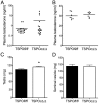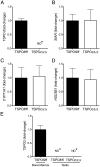Translocator protein/peripheral benzodiazepine receptor is not required for steroid hormone biosynthesis
- PMID: 24174323
- PMCID: PMC3868810
- DOI: 10.1210/en.2013-1556
Translocator protein/peripheral benzodiazepine receptor is not required for steroid hormone biosynthesis
Abstract
Molecular events that regulate cellular biosynthesis of steroid hormones have been a topic of intense research for more than half a century. It has been established that transport of cholesterol into the mitochondria forms the rate-limiting step in steroid hormone production. In current models, both the steroidogenic acute regulatory protein (StAR) and the translocator protein (TSPO) have been implicated to have a concerted and indispensable effort in this cholesterol transport. Deletion of StAR in mice resulted in a critical failure of steroid hormone production, but deletion of TSPO in mice was found to be embryonic lethal. As a result, the role of TSPO in cholesterol transport has been established only using pharmacologic and genetic tools in vitro. To allow us to explore in more detail the function of TSPO in cell type-specific experimental manipulations in vivo, we generated mice carrying TSPO floxed alleles (TSPOfl/fl). In this study we made conditional knockout mice (TSPOcΔ/Δ) with TSPO deletion in testicular Leydig cells by crossing with an anti-Mullerian hormone receptor type II cre/+ mouse line. Genetic ablation of TSPO in steroidogenic Leydig cells in mice did not affect testosterone production, gametogenesis, and reproduction. Expression of StAR, cytochrome P450 side chain cleavage enzyme, 3β-hydroxysteroid dehydrogenase/Δ5-Δ4 isomerase type I, and TSPO2 in TSPOcΔ/Δ testis was unaffected. These results challenge the prevailing dogma that claims an essential role for TSPO in steroid hormone biosynthesis and force reexamination of functional interpretations made for this protein. This is the first study examining conditional TSPO gene deletion in mice. The results show that TSPO function is not essential for steroid hormone biosynthesis.
Figures






Comment in
-
The role of PBR/TSPO in steroid biosynthesis challenged.Endocrinology. 2014 Jan;155(1):6-9. doi: 10.1210/en.2013-2041. Endocrinology. 2014. PMID: 24364584 Free PMC article. No abstract available.
-
On the role of the translocator protein (18-kDa) TSPO in steroid hormone biosynthesis.Endocrinology. 2014 Jan;155(1):15-20. doi: 10.1210/en.2013-2033. Endocrinology. 2014. PMID: 24364587 No abstract available.
References
-
- Simpson ER, Boyd GS. The cholesterol side-chain cleavage system of bovine adrenal cortex. Eur J Biochem. 1967;2(3):275–285 - PubMed
-
- Yago N, Ichii S. Submitochondrial distribution of components of the steroid 11β-hydroxylase and cholesterol sidechain-cleaving enzyme systems in hog adrenal cortex. J Biochem. 1969;65(2):215–224 - PubMed
-
- Churchill PF, Kimura T. Topological studies of cytochromes P-450scc and P-45011β in bovine adrenocortical inner mitochondrial membranes. Effects of controlled tryptic digestion. J Biol Chem. 1979;254(20):10443–10448 - PubMed
-
- Krueger KE, Papadopoulos V. Peripheral-type benzodiazepine receptors mediate translocation of cholesterol from outer to inner mitochondrial membranes in adrenocortical cells. J Biol Chem. 1990;265(25):15015–15022 - PubMed
Publication types
MeSH terms
Substances
Grants and funding
LinkOut - more resources
Full Text Sources
Other Literature Sources
Medical
Molecular Biology Databases
Research Materials

